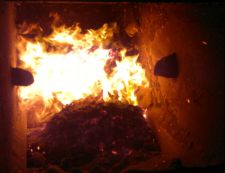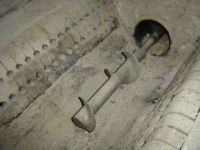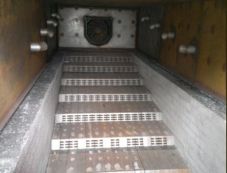
Choosing the right kind of boiler and fuel feed for your specific requirements is a crucial step. Despite the claims of some UK suppliers, most biomass systems are designed to burn either chips or pellets, but not both. For example, A modern 'lightweight' woodchip boiler designed with a fast response in mind is more restricted in terms of fuel moisture content than a more traditional heavy ceramic lined boiler, and may be damaged by the use of very dry fuels such as wood pellets. Wood chip and pellet boilers can be broadly categorised as below, although many newer boilers are hybrids, for example many of the new 'small footprint' wood chip boilers combine an underfeed stoker mechanism with a short walking floor.
Call M Baxter Biomass Consultants to discuss your project and ensure an informed choice.

Basic stoker burners typically consist of a side mounted burner tube located outside the main boiler body. Because the fuel is not fed through the boiler body to the fire bed there is little chance for pre-drying of the fuel. Fuel moisture tolerance is typically maximum 25-30%. Stoker burners typically rely on manual ignition and incorporate a 'slumber mode' which requires a heat sink of typically 2-3% of boiler nominal output. Stoker burners are the most probe to clinker as ash removal relies purely on the motion of incoming fuel. Unless manual cleaning of the boiler is carried out on a daily basis, stoker burners are not recommended for use with fuels other than clean wood chips or pellets. Typically chip size is restricted to either G30 for smaller outputs or G50 for larger burners.

Underfed stoker burners differ as the retort is typically located within the main boiler body. The stoker screw delivers fuel to the base of the retort. The fuel is pushed upwards to form a domed pile. Material at the base of the pile undergoes a certain amount of pre-drying before reaching the fire bed. Fuel moisture tolerance is typically maximum 30-35%. The upwards motion of incoming fuel is more effective at removing ash from the fire bed. If coupled with some kind of automatic cleaning mechanism, underfeed boilers can run without manual cleaning for extended periods. Typically chip size is restricted by the size of the retort to maximum G50. Many modern underfeed stoker boilers are designed with a low thermal mass and are therefore suitable for some degree of cycling, eg. when using biomass for peak loading. The more traditional designs have a very high thermal mass and allow a slightly wetter fuel (up to maximum 40%MC) however, automatic ignition is typically only guaranteed with fuels up to 35%. Care should be taken that these high thermal mass boilers are not cycled too regularly.

Walking floor burners differ significantly from the other types described above. Firstly the stoker system feeding fuel to the fire typically uses a hydraulic ram rather than an auger. Some boilers incorporate a chopping device to cut oversized fuel to size. The incorporation of a hydraulic pump pack allows other technical improvements such as hydraulic slide valves for burn back protection, scraper floor ash removal, and hydraulic heat exchanger cleaning mechanisms. The main differences are the size of the retort or fire bed, which typically extends the full length of the boiler and allows extensive pre-drying of fuels, and the thermal mass of the combustion chamber. Fuel moisture tolerance is in the range of 45-60%. Typically chip size is restricted to G100, but systems equipped with choppers can handle oversized pieces. The continuous movement of the fire bed reduces formation of large clinkers and ensures they are conveyed to the ash screws which are suitable for the task of removing clinker. Flue gas recirculation is typically fitted as standard and reduces clinker and NOx formation by limiting firebed temperatures. Other measures to reduce firebed temperatures include water cooling systems typically connected in series with the boiler return pipe. Contaminated wood fuels including pellets made from recycled materials should only be burnt in walking floor boilers.